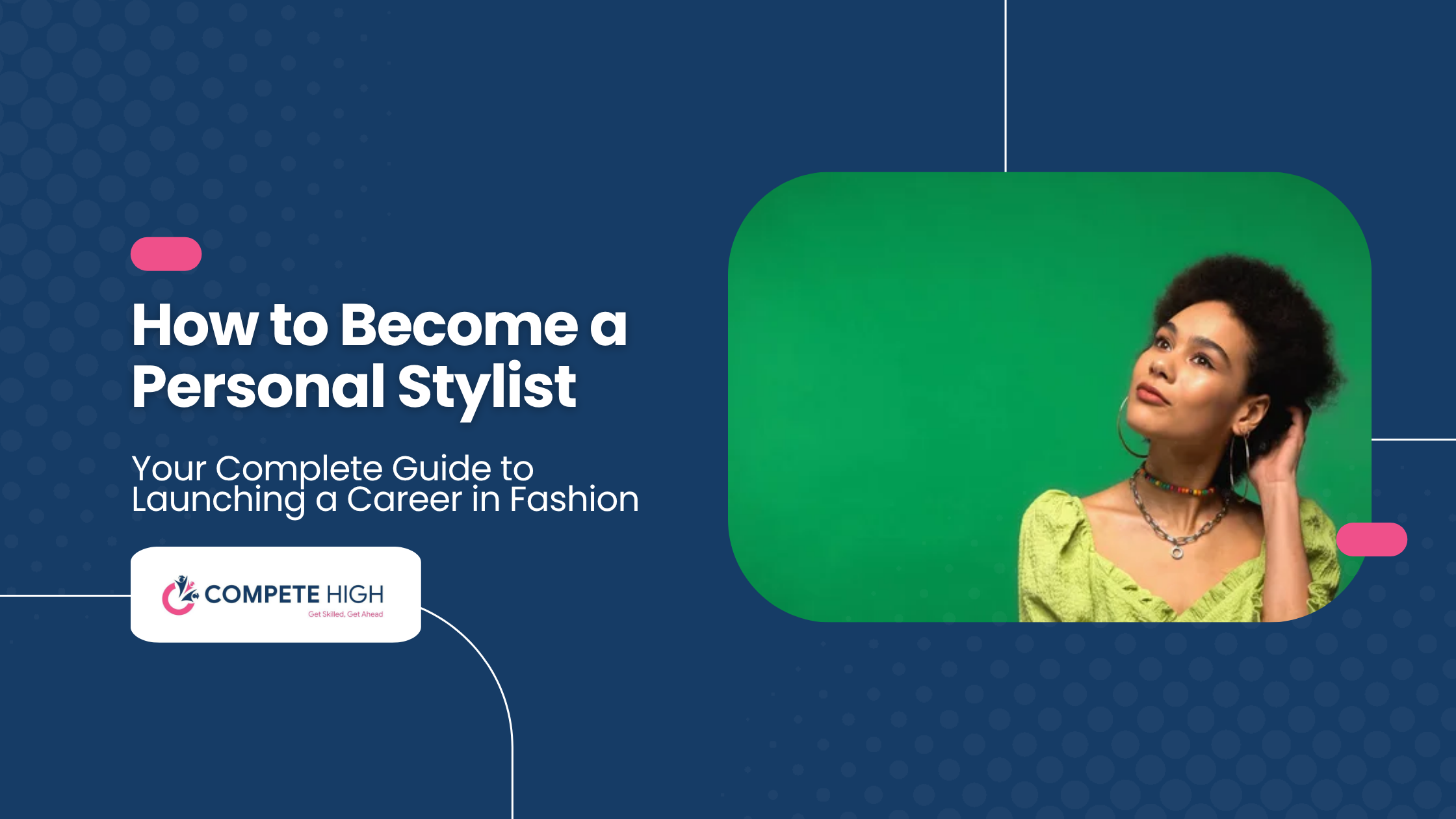
Understanding how to become a personal stylist:
Have you ever thought about building someone’s confidence by helping them see their best self? A career as a personal stylist might be for you. This fascinating profession merges creativity with psychology and business, enabling you to express your passion for fashion while helping others with self-expression.
Personal stylists no longer cater only to celebrities or the wealthy. Many people now seek professional assistance for events, work wardrobes, and personal style updates. This growing demand has significantly increased opportunities for stylists across the UK.
Whether you prefer to work as a freelancer, collaborate with a retail company, or establish your own image consultancy, it’s important to understand how to become a personal stylist, including the required training, certifications, and the differences between various opportunities and pay levels.
Quick Overview
Have you ever wondered how to become a personal stylist and turn your love for fashion into a rewarding career? This guide walks you through every step — from understanding what qualifications you need to becoming a stylist, to building your portfolio, networking, and finding your niche.
Whether you’re starting with no degree or experience, or looking to boost your credibility with a personal stylist certification, you’ll learn how to:
✅ Build confidence and essential styling skills.
✅ Choose the right training and certification path.
✅ Create a strong personal brand and online presence.
✅ Understand how much money you can make as a personal stylist in the UK.
This guide will equip you with everything you need to know about what you need to become a personal stylist, the essential credentials and courses, how to break into the industry with no experience, and your potential earnings.
Section 1: Laying the Foundation — Requirements and Qualifications
The first step in understanding how to become a personal stylist is knowing the qualities that make a stylist truly great. Although a stylist’s job requires a solid knowledge of fashion and trends, the best personal stylists also possess a unique combination of soft skills, creativity, and business awareness.

What Do You Need to Become a Personal Stylist?
Strong interpersonal and communication skills are essential, as much of the work involves listening carefully, identifying the client’s needs, and understanding how they see themselves. Emotional intelligence is equally vital — styling is about much more than clothing; it’s about confidence, self-image, and trust.
A stylist should have a good sense of colour, fit, and proportion, as well as an awareness of current fashion trends. Being organised, dependable, and business-minded is particularly important for freelancers. Most modern stylists also use social media for marketing, making it a key tool for client acquisition and brand building.
What Qualifications Do You Need to Be a Stylist?
One of the most exciting aspects of becoming a personal stylist is that no formal academic qualifications are required to enter the profession. You don’t necessarily need a degree to work in fashion — what truly matters is your skill, credibility, and ability to deliver results for clients.
That said, having relevant education or training can significantly boost your prospects. Many aspiring stylists choose accredited courses in personal styling, fashion retail, or image consultancy to build confidence and gain industry recognition.
Some common pathways include:
- Vocational qualifications, such as a Level 3 Diploma in Fashion Retail or Image Consultancy.
- Short professional courses, offered by the London College of Style, the Fashion Retail Academy, or online platforms like Udemy and FutureLearn.
- Specialised certifications, which we’ll discuss in more detail later.
A qualification is more than just a certificate — it demonstrates your commitment, expands your expertise, and helps build the credibility needed to attract your first clients.
Personal Stylist Certification: Establishing Your Credibility
In a competitive market, obtaining a personal stylist certification can truly set you apart. Although the industry isn’t legally regulated, credentials from a reputable institution reassure clients and employers of your professional training and dedication.
Reputable certification and training options include:
- The London College of Style – offers accredited personal styling diplomas.
- The British College of Professional Styling – provides flexible distance-learning options.
- Style Coaching Institute – combines image consultancy and confidence coaching.
- City & Guilds or CPD-accredited courses – ideal for formal recognition of your studies.
Most certifications cover body shape analysis, colour theory, wardrobe management, personal shopping, client consultation, and branding, providing a well-rounded foundation.
Exploring Training Options: Fashion Stylist Courses
When exploring how to start your career as a stylist, the next step is choosing the right training for your lifestyle, budget, and goals. There’s no single path — it depends on your preferred learning style and availability.
- In-person courses offer immersive experiences, hands-on client work, and valuable networking opportunities.
- Online courses provide flexibility for those balancing work or career transitions.
- Vocational training is perfect for gaining practical experience in fashion retail or image consultancy.
Depending on the course, training can last from a few weeks to several months. The best programmes often include portfolio-building opportunities, which are essential when you’re starting out.
Once qualified, you can explore various career paths and income levels. If you’re wondering how much money you can make as a personal stylist, earnings can vary depending on experience, client base, and whether you work freelance or within a company — a topic we’ll cover in the next section.
Section 2: Launching Your Career — The Practical Path
After gaining the basic knowledge and training, the next step in how to become a personal stylist is to immerse yourself fully in the world of styling. Like many other creative fields, your priority is not only to hone your skills but also to gain exposure and start building momentum. The styling industry revolves around reputation — so, at the beginning, your focus should be on visibility, experience, and developing a strong professional identity.
How to Start Your Career as a Stylist
Start by determining your niche. Some personal stylists focus on wardrobe makeovers, while others specialise in bridal styling, editorial shoots, fashion retail, or corporate image consulting. Defining your niche helps you tailor your learning, market your services effectively, and target the right clients.
Next, create your portfolio. You don’t need celebrity clients at the start — work with friends, family, or even yourself on practice shoots. Take before-and-after photos to showcase your styling ideas and creative process. Social media platforms like Instagram, Pinterest, and TikTok are powerful tools for building visibility and connecting with potential clients.
Networking is equally important. Attend fashion events, connect with boutique owners, collaborate with photographers and make-up artists, and volunteer for small styling projects. These opportunities help you gain experience, build credibility, and open doors to paid work.
Most successful stylists began with little or no experience — and you can too. Focus on research, practice, and consistent self-promotion. Offer styling sessions in exchange for testimonials and client feedback to feature on your website or portfolio.

Shadowing or assisting established stylists is another excellent way to gain insight and practical skills. Many professionals welcome part-time assistants for events, editorial shoots, or personal shopping appointments.
Even short-term industry roles — such as personal shopper, visual merchandiser, or in-store stylist — provide valuable experience. These positions allow you to interact directly with clients, develop your eye for coordination, and refine your communication skills.
Finally, build a strong online presence. Share your styling boards, outfit ideas, and fashion tips to showcase your creative voice and attract your ideal audience. Remember, potential clients often care more about your talent and personal style than your formal experience.
How to Become a Fashion Stylist Without a Degree
A degree in fashion can be helpful, but it’s by no means essential. Many personal stylists in the UK are self-taught or have entered the field through practical experience and focused training rather than university study.
What truly counts is your ability to:
- Understand your client’s personality, lifestyle, and goals.
- Apply the principles of fit, proportion, colour coordination, and trend awareness.
- Communicate advice clearly, constructively, and with confidence.
Instead of spending three or four years on a degree, you can take short professional courses or mentorship programmes to enter the industry quickly. Platforms offering online certifications or weekend workshops can accelerate your progress and help you gain hands-on skills.
If you’re self-teaching, immerse yourself in fashion magazines, style blogs, and digital learning platforms. Analyse why certain outfits work, create capsule wardrobes, and test your styling instincts on real clients. In this industry, your portfolio and professionalism will always speak louder than your academic background.
The Importance of Building Your Brand
Once you’ve gained some experience, treat your styling career as a small business. Establish a personal brand that reflects your values, aesthetic, and approach to styling.
Create a professional website or portfolio page displaying your work, testimonials, and service offerings. Highlight your niche — whether that’s helping professionals refresh their wardrobes, assisting brides with wedding looks, or empowering clients through confidence-based makeovers.
Your brand should demonstrate consistency in tone, visuals, and client experience. Every interaction — from consultation to follow-up — contributes to your reputation and long-term success.
As your confidence grows, consider forming partnerships with boutiques, photographers, or online fashion platforms to expand your visibility.
With the right combination of training, experience, and self-promotion, you can build a thriving styling business — even without traditional qualifications. But before committing full-time, it’s important to understand the financial side of the profession. In the next section, we’ll explore how much money you can make as a personal stylist, including typical earnings, salary expectations, and the factors that influence your income across the UK.
Section 3: Earnings and Growth Potential
When starting out in fashion, many people ask, “Can I earn a living as a stylist?” The answer is absolutely yes — but your income will depend on several key factors, such as your level of experience, the clientele you attract, your marketing strategy, and your location.
How Much Money Can You Make as a Personal Stylist?
As a new personal stylist in the UK, you can expect to earn between £18,000 and £25,000 per year, especially if you begin your career within a retail environment. Freelancers often start lower, but their potential for growth is far higher. Once you’ve established a loyal client base, annual earnings can range from £40,000 to £60,000, with some top stylists making over £100,000 per year.
Earnings in personal styling are highly entrepreneurial — you set your own prices, choose your working hours, and decide the scale of your business. Many stylists increase their income by offering additional services such as online consultations, wardrobe audits, digital shopping packages, and virtual styling subscriptions.
To illustrate how stylists earn, here are a few common pricing models:
- Hourly Rates: Personal stylists in the UK typically charge between £40 and £100 per hour, depending on qualifications and experience.
- Package Pricing: Clients may pay £200–£400 for a half-day personal shopping experience, and £500–£1,000 or more for a complete wardrobe overhaul.
- Retainer or Membership Models: Some stylists provide ongoing monthly support, ensuring consistent income.
- Corporate Contracts: Increasingly, stylists are hired by companies to advise employees on dress codes, provide executive styling, or deliver workplace fashion workshops.
A strong personal brand and social media presence can also open extra income streams through sponsored content, brand partnerships, or media appearances.
Factors That Affect Your Earnings
Like any creative profession, your income grows as your reputation, skills, and network expand. Below are the main factors that influence your long-term earning potential:

- Experience and Credibility: At the start, you may charge less while building trust and your portfolio. As your reputation grows and clients refer you to others, you’ll be able to command higher fees. In this industry, word of mouth is one of the most powerful marketing tools.
- Location: Stylists in major cities such as London, Manchester, and Birmingham often earn more due to higher demand and living costs. In contrast, stylists in smaller towns or rural areas may charge less but often enjoy loyal, long-term clients and a steadier workload.
- Client Type: Working with corporate clients, high-end consumers, or bridal clients typically brings higher fees than casual wardrobe consultations.
- Service Diversity: Offering various services — from personal shopping to virtual styling — allows you to attract a broader client base and maintain steady work throughout the year.
- Marketing and Online Presence: Stylists who actively share their work and transformations online tend to attract more clients. Platforms like Instagram, Pinterest, and TikTok are invaluable for showcasing your portfolio and networking.
- Specialisation: Choosing a niche such as men’s fashion, sustainable styling, or plus-size wardrobes can increase your expertise and confidence, allowing you to charge premium rates.
In the early stages, you may take on low-paid or even unpaid projects to gain exposure, but every experience builds your portfolio and credibility. Over time, satisfied clients, testimonials, and consistent self-promotion will elevate both your income and your professional standing.
The Path from Beginner to Professional
Let’s visualise how to become a personal stylist with no experience as a step-by-step journey:
- Year 1: Focus on building confidence, gaining hands-on experience, and offering affordable sessions to attract clients. Your earnings may be modest, but you’ll be developing crucial skills and gathering valuable feedback.
- Years 2–3: By now, you should have a clearer brand identity and a growing client base. Local boutiques or retailers may begin referring clients, and you might consider transitioning from part-time work to full-time freelancing.
- Years 5 and Beyond: As your experience and reputation grow, so do your opportunities. You might work as:
- A consultant for retail brands.
- A stylist for film, television, or editorial shoots.
- An image coach for executives or public figures.
- A trainer offering workshops or courses for aspiring stylists.
- A consultant for retail brands.
Your styling career will evolve as you do. With continuous learning, expanding networks, and creative growth, your professional and financial success will rise in tandem.
The Reality of Freelancing
Freelancing gives personal stylists independence but also demands discipline. You’ll need to manage your schedule, promote your services, and handle the business side — including budgeting, invoicing, and client management.
There will be quieter months, particularly early on, so planning for seasonal fluctuations is essential. For instance, “new year, new you” January and pre-summer periods are typically busy. With time, you’ll recognise these cycles and adjust your marketing accordingly.
To maintain financial stability, consider diversifying your services — offering online consultations, corporate workshops, or style masterclasses can help sustain income during slower periods.
Becoming a personal stylist in the UK is a rewarding journey — both financially and emotionally. You’ll witness clients transform not only in appearance but also in confidence, building lasting relationships along the way.
Whether you’re exploring how to become a fashion stylist without a degree or researching the best fashion stylist courses to boost your skills, remember: every step you take adds to your experience and credibility.
In the final section, we’ll summarise everything and inspire you to take your first steps towards a fulfilling and successful styling career.
Your Next Step to Becoming a Professional Stylist
You cannot truly become a personal stylist without understanding people on a deeper level. Styling is as much about psychology as it is about fashion. A great stylist helps clients build confidence and express their best selves, blending creativity with compassion. Whether you’re helping someone rebuild their wardrobe after a life change, dressing a bride for her wedding, or refining a client’s professional image, remember — you have the power to change lives through style.

By now, you should know that how to become a personal stylist doesn’t require a university degree or years of industry experience. What you need most is motivation, discipline, and a genuine desire to help others. Every expert began as a beginner — taking small, consistent steps that led to long-term success. Skills are built over time, experience is earned, and your services will grow stronger as you learn to market yourself effectively.
Step 1: Learn and Practise Daily
The fashion industry moves quickly, and a successful stylist must always stay curious and adaptable. Read fashion magazines, analyse trends, observe people’s wardrobes, and notice how styles evolve through the seasons. You don’t need to follow every trend, but you do need to understand balance — colour, proportion, texture, and how they interact.
Spend time analysing both successful and unsuccessful outfits — on yourself and others. Create capsule wardrobes, develop seasonal looks, and record your progress. The more you practise, the more naturally your creative instincts will develop.
If you’re exploring how to become a personal stylist with no experience, daily practice is your best teacher. Immersing yourself in fashion, experimenting with combinations, and reflecting on what works (and what doesn’t) will accelerate your growth faster than any classroom could.
Step 2: Build a Portfolio That Tells Your Story
Your portfolio is one of your most valuable marketing and branding tools. It reflects your creativity, professionalism, and progress. Even when you’re just starting out, treat every opportunity — whether it’s styling a friend, organising a photoshoot, or curating outfits for social media — as a chance to showcase your work.
Always take before-and-after photos, collect client feedback, and include styling notes that demonstrate your approach. Present these materials neatly in a digital or printed format that’s easy to share. Over time, your portfolio will evolve, representing your growing expertise and your journey from beginner to professional.
Step 3: Earn Credibility Through Certification and Networking
Although personal styling in the UK isn’t a regulated industry, obtaining recognised certifications can strengthen your credibility and attract clients. Completing fashion stylist courses from reputable institutions such as The London College of Style, The Style Coaching Institute, or The British College of Professional Styling can give you a competitive edge.
Certification shows commitment to your craft and reassures clients that you’ve invested time in developing your skills.
Equally important is networking. Every relationship you form — with photographers, boutiques, make-up artists, or influencers — can lead to future opportunities. In the styling world, your reputation is your currency, and word of mouth can be your most powerful marketing tool.
Step 4: Create Your Professional Brand
Your brand is an extension of your personal style. From your online presence and social media profiles to your logo, tone of voice, and business email — everything should reflect the image you want to project.
Choose a clear visual identity — colour palette, name, and overall aesthetic — that speaks to your target audience, whether they are professionals, creatives, or individuals seeking confidence through fashion.
A strong brand communicates professionalism, reliability, and consistency. It sets you apart in a competitive industry and builds recognition over time.
Step 5: Build a Career, Not Just a Job
When you start out, it’s easy to focus solely on gaining clients. However, long-term success comes from building a sustainable business. Think beyond single sessions — develop packages, workshops, and products that add value and keep clients coming back.
As your career progresses, consider expanding your offerings through corporate styling workshops, online wardrobe consultancy, or mentoring aspiring stylists. Many successful professionals grow their influence through blogging, YouTube channels, or brand partnerships — all of which enhance visibility and income potential.
Remember, how to become a fashion stylist without a degree or with limited experience is about persistence, creativity, and self-belief. The personal styling career you build is entirely your own — flexible, fulfilling, and full of opportunity. With continued learning, networking, and confidence, you can establish a name that stands for transformation, authenticity, and style.
Your Next Step to Becoming a Professional Stylist
Becoming a personal stylist isn’t just about understanding clothes — it’s about understanding people. It’s about confidence, creativity, and compassion. Whether you’re helping someone rebuild their wardrobe after a major life change, preparing a bride for her big day, or guiding a client towards a more professional look, your work has a genuine emotional impact.
If you’ve made it this far, you already know that how to become a personal stylist doesn’t require a fashion degree or years of prior experience. What it does require is drive, discipline, and a true desire to help others look and feel their best. The path to success begins with small, practical steps — building your skills, gaining experience, and learning how to market your services effectively.
Step 1: Commit to Learning and Practising Daily
The fashion world moves fast, and successful stylists are lifelong learners. Read fashion publications, attend workshops, and observe how trends evolve. You don’t need to chase every fad, but understanding how colour, proportion, and texture interact will help you guide clients with authority and confidence.

Spend time analysing what works and what doesn’t — both on yourself and others. Try curating capsule wardrobes, experimenting with seasonal looks, and documenting your results. The more you practise, the more instinctive your styling will become.
Exploring accredited fashion stylist courses can also help you stay ahead of trends and strengthen your creative skillset.
Step 2: Build a Portfolio That Tells Your Story
Your portfolio is your most powerful asset. It’s what future clients and employers will use to gauge your talent, professionalism, and creativity. Even if you’re starting small, treat every opportunity — from styling a friend’s outfit to organising a local photoshoot — as a chance to showcase your abilities.
Include before-and-after photos, styling notes, and client feedback whenever possible. Present your work in a clean, professional format — ideally online, so it’s easy to share. Over time, your portfolio will become living proof of your growth and expertise.
Step 3: Earn Credibility Through Certification and Networking
While personal styling in the UK isn’t regulated, obtaining a personal stylist certification can give you a major advantage. Clients are far more likely to trust a stylist who has invested in professional training through accredited institutions such as the London College of Style, the Style Coaching Institute, or the Fashion Retail Academy.
In addition to certification, networking is key to building your career. Attend industry events, collaborate with photographers and make-up artists, and connect with boutique owners. Each professional relationship you build can lead to your next opportunity. In the world of styling, your reputation truly is your currency.
Step 4: Develop a Professional Brand Identity
From your social media pages to your email signature, every element should reflect your aesthetic and professionalism. Choose a brand name, colour palette, and tone that align with the clients you want to attract — whether you’re targeting high-end professionals, creative individuals, or everyday people looking for confidence through fashion.
A well-defined brand helps you stand out in a competitive market. It communicates that you are consistent, trustworthy, and serious about your craft. The same principles you apply to styling others should be reflected in how you present yourself and your business.
Step 5: Think Long-Term — Build a Career, Not Just a Job
In the early stages, it’s easy to focus solely on getting clients, but the real goal is to build a sustainable career. As you grow, think about how you can expand your services and establish yourself as a full-service style expert.
You might develop corporate image workshops, offer online wardrobe consultations, or mentor aspiring stylists. Many professionals also expand their reach through blogging, YouTube, or brand collaborations — all of which increase visibility and income potential.
Your career in personal styling is what you make of it. With time, dedication, and creativity, your name can become synonymous with confidence, taste, and transformation.
Your Journey Starts Now
So — how do you become a personal stylist?
You start exactly where you are — with your curiosity, creativity, and passion for helping others. The path may include formal training, portfolio building, or assisting established stylists, but the real secret lies in taking consistent action.
If you’re ready to begin, start today. Research certified courses, create your first styling concept, or offer to help a friend revamp their wardrobe. Every small step brings you closer to the professional career you imagine.
Personal styling isn’t just about fashion — it’s about confidence, identity, and transformation. And when you help someone look in the mirror and genuinely love what they see, you’ll know you’ve chosen a career worth every moment of effort.








